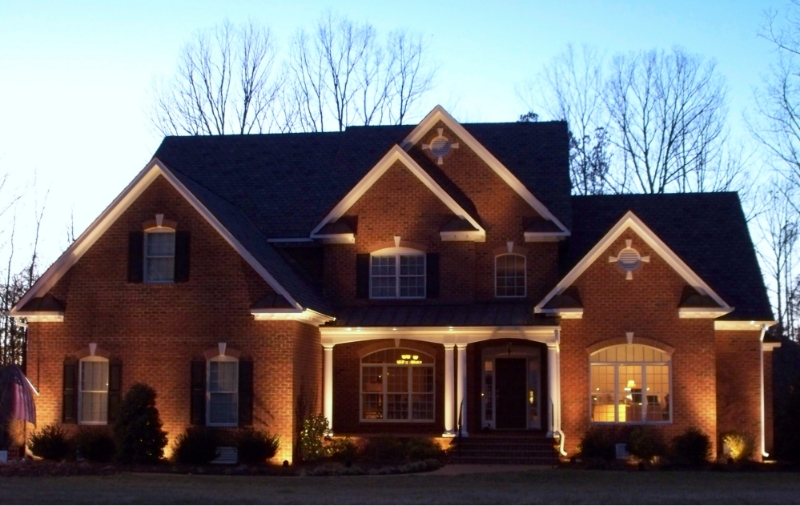
Many of our customers have inquired about converting their older outdoor lighting systems to LED. And, many have had us do the conversion for them. Perhaps you have also considered conversion of your own low voltage outdoor lighting system but weren’t quite sure how to do it or why to do it. This blog may help. Please continue to read on as we guide you through the facts to consider.
75%-80% Savings in Electricity Consumption
First and foremost is energy consumption. The LED’s we are using will save you between 75%-80% in electricity consumption. Our typical halogen well light uses a 35 watt halogen bulb. Our replacement LED’s are between 5.5 and 8 watts. That’s 27 fewer watts used per light per hour. Our customers have an average of 20 lights installed. Multiply the savings per light by the number of lights: 27 x 20 = 540 watts saved per hour. Assuming you run your system an average of 5 hours per night, the savings in electricity consumption is 2,700 watts less per night, or 985,000 watts saved per year, and that’s just for the well lights. Path lights with halogen bulbs use 20 watts per fixture, and the LED’s are only 4 watts. That’s 16 watts less per path light. At the end of the day, that’s a lot of electricity savings, and it all adds up.

Less Maintenance with Longer Life LEDs
Less Maintenance with Longer Life LEDs
The second reason is maintenance. Halogen bulbs we have installed have a 4,000 hour average life. The LEDs which we install today have a 50,000 hour average life. That is more than 10 times the average life of the halogen bulb. This means far less maintenance year after year and less bulb changes. And, the LEDs which we use come with a 3 year warranty versus a 1 Year warranty with the halogen bulbs. Potentially, you may never have to change a bulb again.

Similar Lighting Effect with LED
Similar Lighting Effect with LED
Third is the lighting effect. We watched, we waited, and we tested various LEDs for 4-5 years before we ourselves offered them because the color of the light output was not as natural as halogen. But with product and technology improvements, the LEDs which we use today produce a similar natural lighting effect to what we all became accustomed to with halogen. But be careful! All LEDs are not created equal and do not produce the same color of light output.

Four years ago, I had our guys convert all of our own fixtures to LED while my wife was out of town as a test to see if she would notice a difference. A month later, we were coming home from dinner and she asked me, “When are the guys coming to change us over to LEDs?” I intentionally had not told her that it had been done as I wanted to see if she noticed any difference. Low and behold, she did not and was quite pleasantly surprised when I told her it had been done a month ago. The point to the story is that if you are concerned that our LEDs won’t look the same as your halogen bulbs, there is nothing to worry about. No bluish-white or “ghoulish” lighting effect here. Only a warm white, natural light, very similar to what you are accustomed to with your current lighting.
These two brick homes show how there is little difference in the lighting effect of halogen vs LED.

Halogen Low Voltage Lighting

LED Low Voltage Lighting
All of the photos shown, with the exception of the one above, are projects which we have done over the last 2 -3 years with LED.

Smaller Fixture Size & Conversion Options
The fourth reason is smaller fixture size. Most of the LEDs we use are smaller in size as compared to their counterpart in a halogen bulb. As a result, many of the fixtures manufactured today are smaller in size and more easily hidden when planted into a bedding area or behind a shrub. One recommendation for you though is try to stick with fixtures that are manufactured with natural materials such as brass or copper. They will weather better and last longer. Here are a couple of photos of fixtures we like to use:


There are two options for conversion. The first is replacing fixture for fixture. The second is to use the same fixture but replace the bulbs with LEDs. If you choose the latter, make sure the current fixtures are water tight and not leaking. LEDS generally do not like water. And try to find and use LEDS that are designed for exterior use and for landscape lighting applications. Avoid cheap LEDs if you hope to achieve the longer average life. And, in either case, know what the operating voltage range is for the LEDs (most are in the 9-14v range).In any case, make sure your transformer is not supplying higher voltage levels as the LEDs will immediately burn out.
Maybe It Is Time For An Upgrade!
Lighting manufacturing processes and technology has changed very dramatically with LEDs. If you are reading this blog, my guess is that you have traded in one or more cars over the last 5 – 10 years. Maybe it’s time for you to trade in your in lights. Let’s all do our part to reduce electrical consumption and take a much “greener” approach to your outdoor lighting system.

